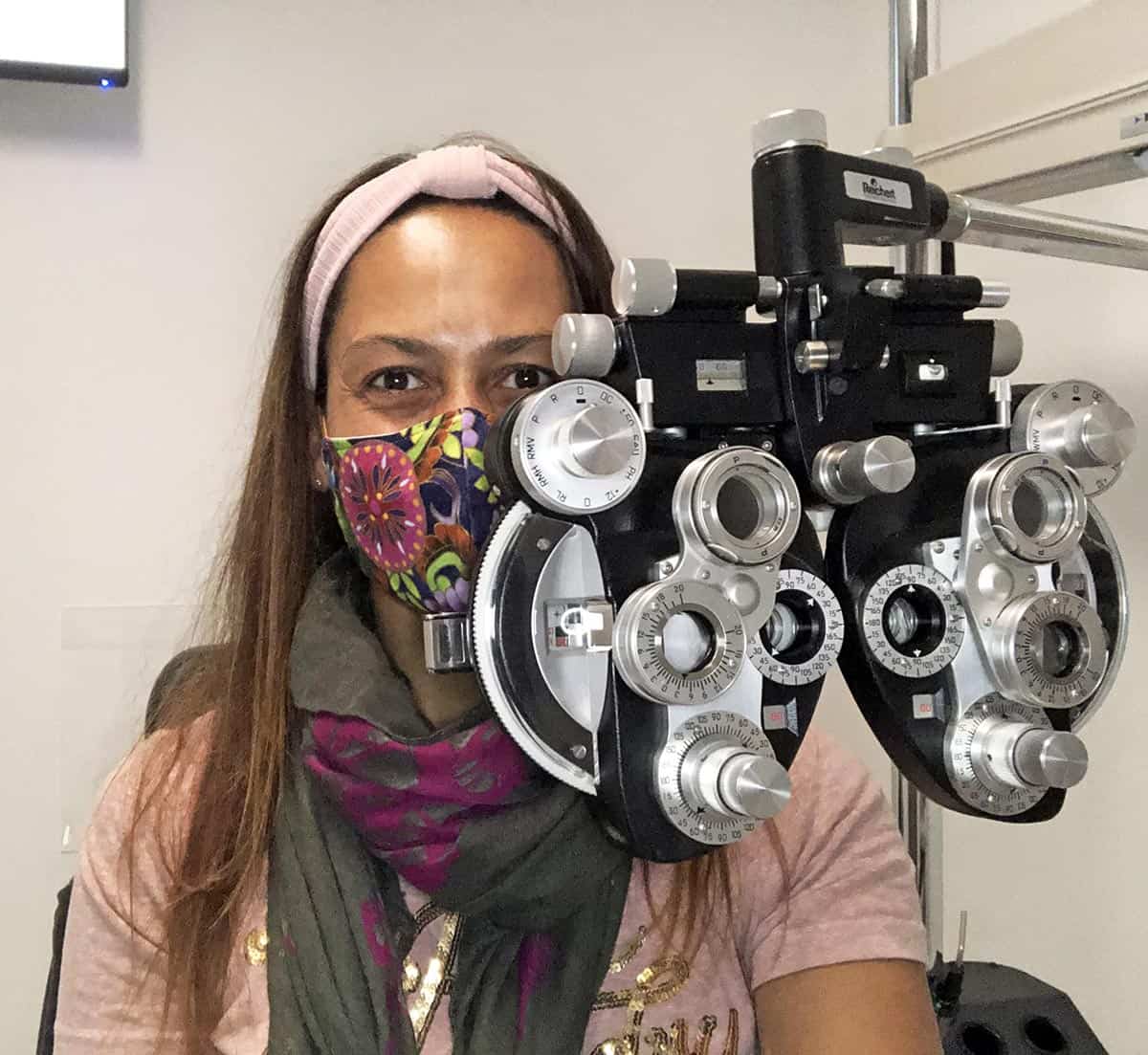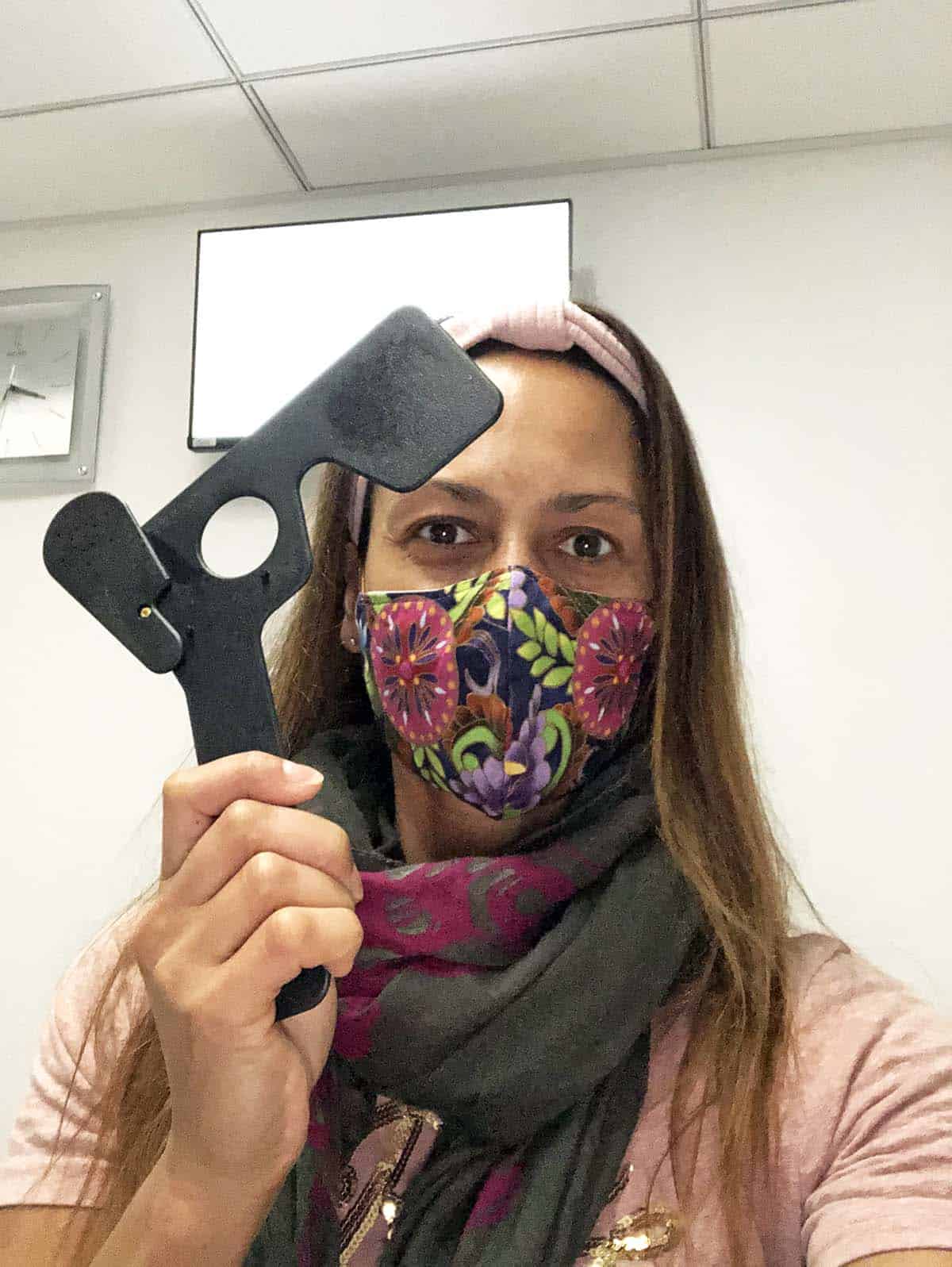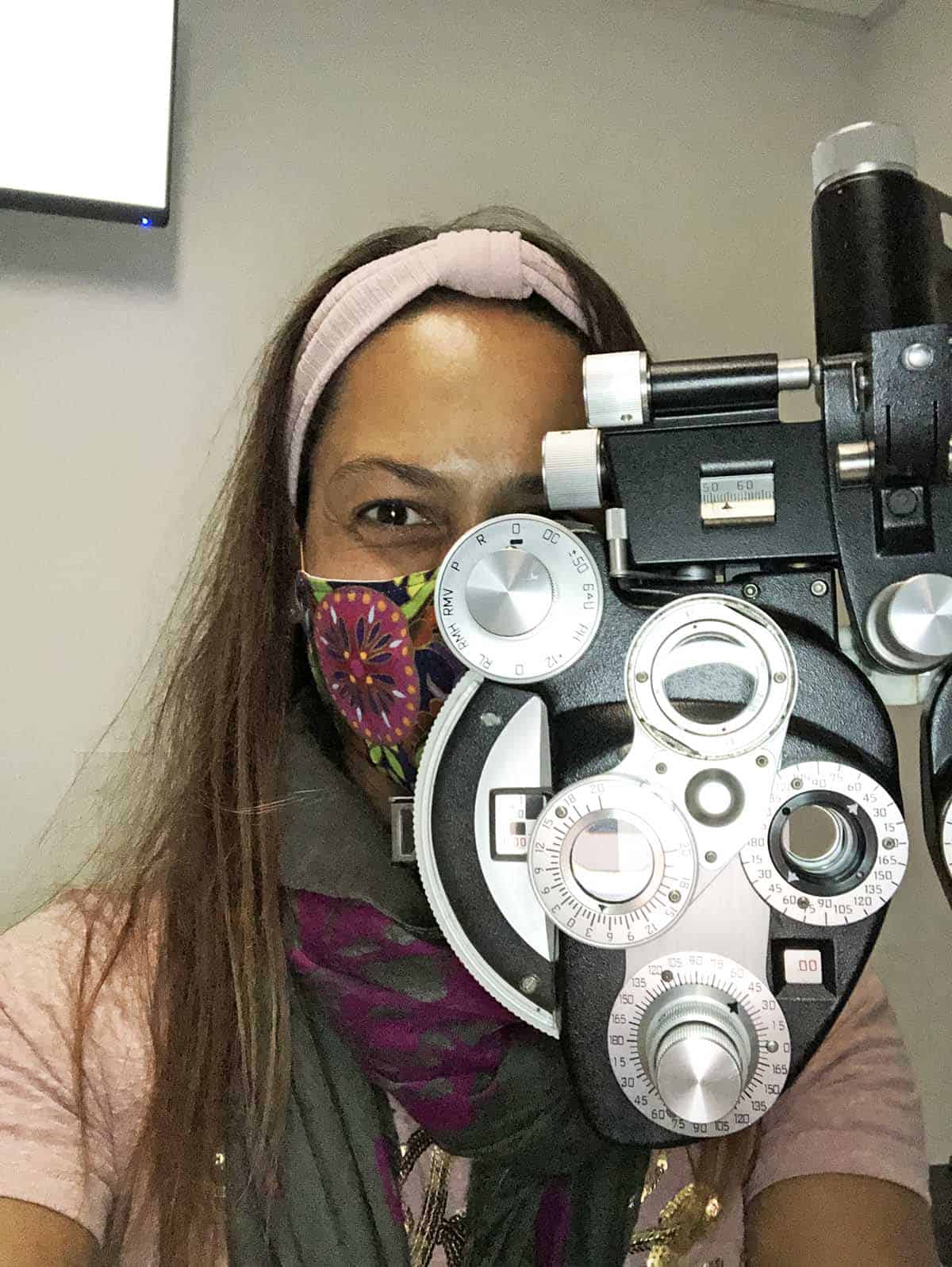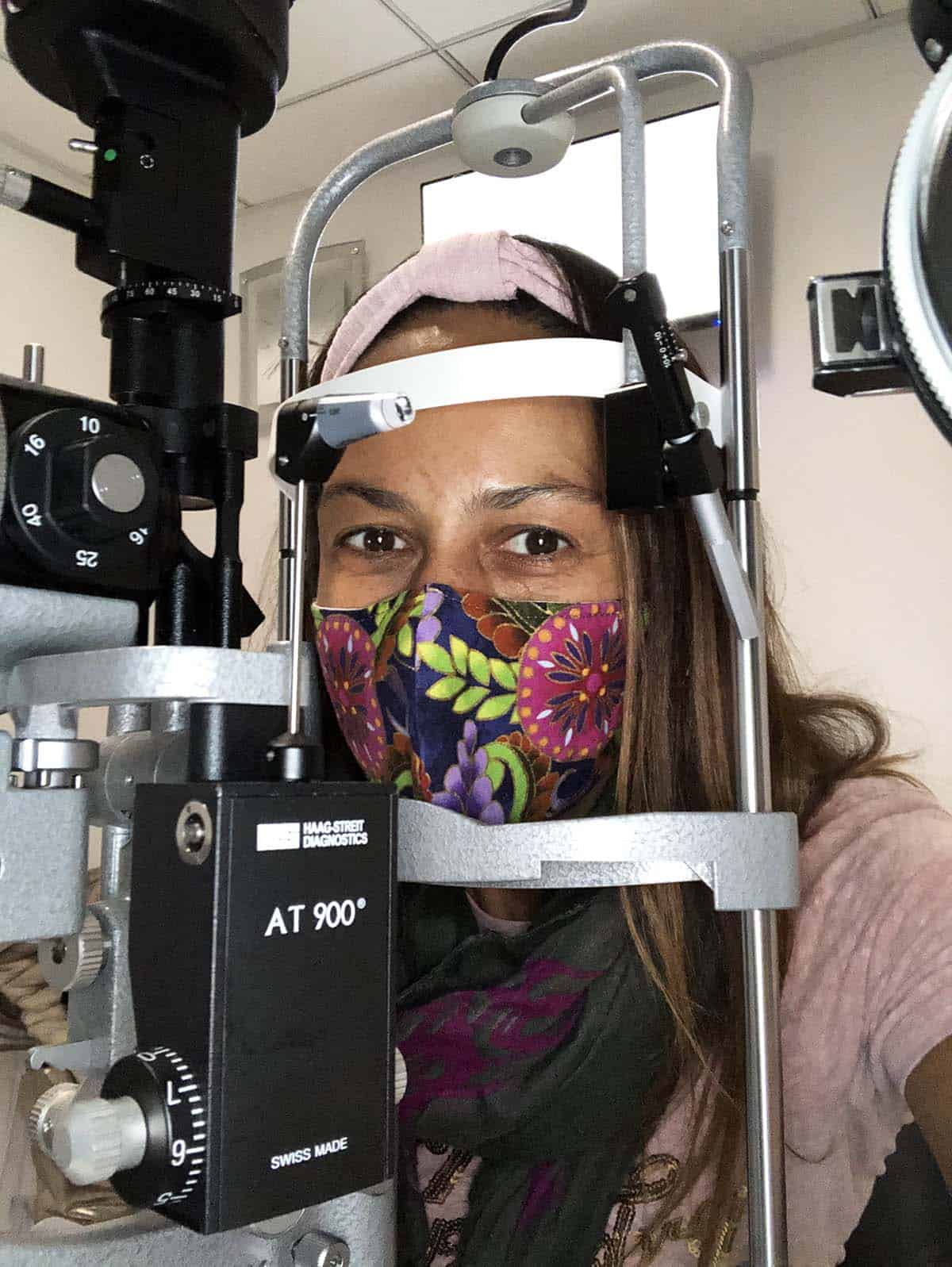
I’ve lived with diabetes since 1997 and have made my eyes a priority by seeing my eye care professional (Ophthalmologist) every year for a thorough eye exam.
I do this because, as someone living with diabetes, I’m at risk of developing diabetic retinopathy which can result in diabetic macular edema.
7.7 million people in the United States have diabetic retinopathy and it’s the leading cause of blindness in people ages 20 to 74 in the US.
Diabetic retinopathy treatment options are available, but diabetic retinopathy can lead to serious vision problems and potential blindness if left undetected. I don’t want that to happen to me, and I’m sure you don’t either.
In this post, I’ll walk you through why it’s so important to get your eyes checked regularly, what my annual eye exam looks like, and what can be done to help protect your eyes should you develop symptoms of diabetic retinopathy.
This post is sponsored by Regeneron’s Look To Your Future campaign.


What is diabetic retinopathy and how can you reduce the risk of developing it?
Diabetic retinopathy is a condition where the blood vessels in your eye become damaged due to chronically high blood sugar levels.
An eye exam is the only way of catching it early and being able to stop the progression. Early detection, timely treatment and appropriate follow-up care can reduce the risk of severe vision loss by 95%.
While the early stages of diabetic retinopathy may not include any visible symptoms, some signs that you should look out for are:
- Blurriness in the center of vision
- Blind spots or patches
- Straight lines that look wavy
- Colors that look dull or washed out
Symptoms can appear in one or both eyes, but could also be a sign of other underlying vision issues, so if you experience any of these symptoms, contact your doctor for an appointment right away.
Although nearly 1 in 2 people living with diabetes in the United States develop diabetic retinopathy, there are steps you can take to reduce the risk of being diagnosed with diabetic retinopathy.
Specific things you can do right now to help reduce the risk are:
- Stop smoking
- Manage your daily blood sugar levels to the best of your ability and seek help if you’re struggling
- Discuss your A1c target with your medical team and work towards your goal
- Manage your blood cholesterol levels
- Manage your blood pressure
- Take your medication as directed by your medical team
- Eat nutritious food, eat quantities in moderation, and exercise regularly to maintain a healthy weight
- See an eye doctor annually for a comprehensive eye exam and vision test
My annual visit to the eye doctor
I’m not good when it comes to anyone touching my eyes (myself included). Even having someone apply mascara to my eyelashes is uncomfortable, so I have some level of anxiety when it comes to my annual eye exams.
But eye exams are so important, and if you find the right eye doctor, it can be a rather interesting experience (especially if you geek out over the equipment like I do).
After being checked in at the doctor’s office, my doctor’s assistant checked my eyesight (a Visual Acuity Test). The assistant handed me a mask-like instrument that covers one eye, turned off the light, and asked me to read the letters on a lighted board. That’s pretty straightforward.


My doctor also did a full vision test this year using a Phoropter. I don’t mind that test either, the only annoyance was that the lenses kept fogging up as I was wearing a mask during the exam.


Next, they put drops in my eyes to dilate my pupils so that the eye doctor can examine the retina and measure my eye pressure (Tonometry). I don’t like that part. Not because it hurts (although the drops do sting a little) but because it’s something being done close to my eyes. I told you, I’m weird with this.
The next step is really easy. You just sit around and wait until your eyes are dilated enough for the doctor to do the exam. I usually bring music or listen to a podcast.
As your eyes dilate, it becomes hard to focus, so reading a book or doing work on your phone or laptop isn’t really possible. I’ve been told that it can take a little longer for dark eyes like mine to dilate, and sometimes they need to add more drops.
My eye doctor then has me place my head in something called a Slit Lamp, which is a microscope with a bright light. She then uses small magnifying glasses to examine my eyes. Having a bright light shining into your eye is not the most comfortable thing but my doctor and I will usually chitchat while she does the exam and it’s never as bad as I expect.


She then finished the exam by doing an indirect ophthalmoscopy (and yes, I had to ask her the names of all the different exams). Here she wears an optical instrument on her head and examines the back of my eyes.
The whole appointment took about an hour and my eyes got the all-clear…
I usually drive myself to the appointment and then run a few errands or work in a coffee shop after my appointment until the dilation of my eyes has come down enough that I can see clearly and it’s safe to drive home (your eyes are very light sensitive for a while after the dilation and you shouldn’t drive right away.)


This year, things were a little different because of the pandemic and I ended up having to take a taxi back and forth.
But I still go, and I will continue to do so every year (or more often if needed) because it gives me peace of mind knowing that I don’t have any issues with my eyes and that if anything starts to show up, my doctor will notice and take action.
What can you do if you develop diabetic retinopathy?
For many, vision loss due to diabetic retinopathy is irreversible, but the National Eye Institute (NEI) states that early detection, timely treatment and appropriate follow-up care can help reduce your risk of vision loss by 95 percent.
The three most common ways of treating DR are:
- Anti-VEGF Medicines
- Laser Therapy
- Steroids
Most of the treatments available aim at stopping the progression of diabetic retinopathy and preserving your vision, which again, is why seeing your eye doctor at least annually is so important for early detection.
You can find a lot more information about eye health and diabetic retinopathy on LookToYourFuture.com.

Success! Now check your email to download the eBook chapter.
/* Layout */ .ck_form { /* divider image */ background: #fff url(data:image/gif;base64,R0lGODlhAQADAIABAMzMzP///yH/C1hNUCBEYXRhWE1QPD94cGFja2V0IGJlZ2luPSLvu78iIGlkPSJXNU0wTXBDZWhpSHpyZVN6TlRjemtjOWQiPz4gPHg6eG1wbWV0YSB4bWxuczp4PSJhZG9iZTpuczptZXRhLyIgeDp4bXB0az0iQWRvYmUgWE1QIENvcmUgNS41LWMwMTQgNzkuMTUxNDgxLCAyMDEzLzAzLzEzLTEyOjA5OjE1ICAgICAgICAiPiA8cmRmOlJERiB4bWxuczpyZGY9Imh0dHA6Ly93d3cudzMub3JnLzE5OTkvMDIvMjItcmRmLXN5bnRheC1ucyMiPiA8cmRmOkRlc2NyaXB0aW9uIHJkZjphYm91dD0iIiB4bWxuczp4bXA9Imh0dHA6Ly9ucy5hZG9iZS5jb20veGFwLzEuMC8iIHhtbG5zOnhtcE1NPSJodHRwOi8vbnMuYWRvYmUuY29tL3hhcC8xLjAvbW0vIiB4bWxuczpzdFJlZj0iaHR0cDovL25zLmFkb2JlLmNvbS94YXAvMS4wL3NUeXBlL1Jlc291cmNlUmVmIyIgeG1wOkNyZWF0b3JUb29sPSJBZG9iZSBQaG90b3Nob3AgQ0MgKE1hY2ludG9zaCkiIHhtcE1NOkluc3RhbmNlSUQ9InhtcC5paWQ6MUQ5NjM5RjgxQUVEMTFFNEJBQTdGNTQwMjc5MTZDOTciIHhtcE1NOkRvY3VtZW50SUQ9InhtcC5kaWQ6MUQ5NjM5RjkxQUVEMTFFNEJBQTdGNTQwMjc5MTZDOTciPiA8eG1wTU06RGVyaXZlZEZyb20gc3RSZWY6aW5zdGFuY2VJRD0ieG1wLmlpZDoxRDk2MzlGNjFBRUQxMUU0QkFBN0Y1NDAyNzkxNkM5NyIgc3RSZWY6ZG9jdW1lbnRJRD0ieG1wLmRpZDoxRDk2MzlGNzFBRUQxMUU0QkFBN0Y1NDAyNzkxNkM5NyIvPiA8L3JkZjpEZXNjcmlwdGlvbj4gPC9yZGY6UkRGPiA8L3g6eG1wbWV0YT4gPD94cGFja2V0IGVuZD0iciI/PgH//v38+/r5+Pf29fTz8vHw7+7t7Ovq6ejn5uXk4+Lh4N/e3dzb2tnY19bV1NPS0dDPzs3My8rJyMfGxcTDwsHAv769vLu6ubi3trW0s7KxsK+urayrqqmop6alpKOioaCfnp2cm5qZmJeWlZSTkpGQj46NjIuKiYiHhoWEg4KBgH9+fXx7enl4d3Z1dHNycXBvbm1sa2ppaGdmZWRjYmFgX15dXFtaWVhXVlVUU1JRUE9OTUxLSklIR0ZFRENCQUA/Pj08Ozo5ODc2NTQzMjEwLy4tLCsqKSgnJiUkIyIhIB8eHRwbGhkYFxYVFBMSERAPDg0MCwoJCAcGBQQDAgEAACH5BAEAAAEALAAAAAABAAMAAAICRFIAOw==) repeat-y center top; font-family: “Helvetica Neue”, Helvetica, Arial, Verdana, sans-serif; line-height: 1.5em; overflow: hidden; color: #666; font-size: 16px; border-top: solid 20px #3071b0; border-top-color: #3071b0; border-bottom: solid 10px #3d3d3d; border-bottom-color: #1d446a; -webkit-box-shadow: 0px 0px 5px rgba(0,0,0,.3); -moz-box-shadow: 0px 0px 5px rgba(0,0,0,.3); box-shadow: 0px 0px 5px rgba(0,0,0,.3); clear: both; margin: 20px 0px; } .ck_form, .ck_form * { -webkit-box-sizing: border-box; -moz-box-sizing: border-box; box-sizing: border-box; } #ck_subscribe_form { clear: both; } /* Element Queries — uses JS */ .ck_form_content, .ck_form_fields { width: 50%; float: left; padding: 5%; } .ck_form.ck_horizontal { } .ck_form_content { border-bottom: none; } .ck_form.ck_vertical { background: #fff; } .ck_vertical .ck_form_content, .ck_vertical .ck_form_fields { padding: 10%; width: 100%; float: none; } .ck_vertical .ck_form_content { border-bottom: 1px dotted #aaa; overflow: hidden; } /* Trigger the vertical layout with media queries as well */ @media all and (max-width: 499px) { .ck_form { background: #fff; } .ck_form_content, .ck_form_fields { padding: 10%; width: 100%; float: none; } .ck_form_content { border-bottom: 1px dotted #aaa; } } /* Content */ .ck_form_content h3 { margin: 0px 0px 15px; font-size: 24px; padding: 0px; } .ck_form_content p { font-size: 14px; } .ck_image { float: left; margin-right: 5px; } /* Form fields */ .ck_errorArea { display: none; } #ck_success_msg { padding: 10px 10px 0px; border: solid 1px #ddd; background: #eee; } .ck_label { font-size: 14px; font-weight: bold; } .ck_form input[type=”text”], .ck_form input[type=”email”] { font-size: 14px; padding: 10px 8px; width: 100%; border: 1px solid #d6d6d6; /* stroke */ -moz-border-radius: 4px; -webkit-border-radius: 4px; border-radius: 4px; /* border radius */ background-color: #f8f7f7; /* layer fill content */ margin-bottom: 5px; height: auto; } .ck_form input[type=”text”]:focus, .ck_form input[type=”email”]:focus { outline: none; border-color: #aaa; } .ck_checkbox { padding: 10px 0px 10px 20px; display: block; clear: both; } .ck_checkbox input.optIn { margin-left: -20px; margin-top: 0; } .ck_form .ck_opt_in_prompt { margin-left: 4px; } .ck_form .ck_opt_in_prompt p { display: inline; } .ck_form .ck_subscribe_button { width: 100%; color: #fff; margin: 10px 0px 0px; padding: 10px 0px; font-size: 18px; background: #0d6db8; -moz-border-radius: 4px; -webkit-border-radius: 4px; border-radius: 4px; /* border radius */ cursor: pointer; border: none; text-shadow: none; } .ck_form .ck_guarantee { color: #626262; font-size: 12px; text-align: center; padding: 5px 0px; display: block; } .ck_form .ck_powered_by { display: block; color: #aaa; } .ck_form .ck_powered_by:hover { display: block; color: #444; } .ck_converted_content { display: none; padding: 5%; background: #fff; } /* v6 */ .ck_form_v6 #ck_success_msg { padding: 0px 10px; } @media all and (max-width: 403px) { .ck_form_v6.ck_modal .ck_close_link { top: 30px; } } @media all and (min-width: 404px) and (max-width: 499px) { .ck_form_v6.ck_modal .ck_close_link { top: 57px; } } .ck_guarantee, .ck_form_title, .ck_image { display: none !important; } .ck_form_container:not(.ck_modal) { max-width: 780px !important; margin: 0 auto !important; } .ck_form_container .ck_form { background-color: #00a9e0 !important; } .ck_modal .ck_form { left: auto !important; max-width: 780px !important; margin: 5% auto !important; width: 100% !important; position: relative !important; } .ck_form { background: none !important; box-shadow: none !important; -webkit-box-shadow: none !important; } .ck_form_content { width: 35% !important; padding: 2% !important; float: left !important; } .ck_form_fields { width: 65% !important; float: left !important; padding: 3% !important; } .ck_description img { border: 5px solid #fff; width: 200px; height: auto; } .ck_form_container .ck_form { border: none !important; } .ck_form_fields:before { content: “Do you want to be Diabetes Strong?”; font-size: 30px; display: block; text-align: center; font-weight: 600; letter-spacing: 1.2px; color: #fff; width: 90%; margin: 0 auto; line-height: 1; text-transform: uppercase; } .ck_subscribe_form:before { content: “Sign up to receive a free chapter from Christel’s Fit With Diabetes eBook.”; text-align: center; display: block; color: #fff; font-size: 18px; width: 70%; margin: 3% auto; line-height: 1.5; } .ck_control_group.ck_first_name_field_group { margin-right: 1%; } .ck_control_group.ck_first_name_field_group, .ck_control_group.ck_email_field_group { float: left; width: 49% !important; } .ck_form input[type=”text”], .ck_form input[type=”email”] { border: none; background-color: #fff; box-shadow: none; border-radius: 0; padding: 10px; } .ck_form .ck_subscribe_button { border-radius: 0; background: #fff; font-weight: 600; color: #000; height: 39px; line-height: 1; } .ck_label { font-size: 15px; font-weight: 600; text-transform: uppercase; color: #fff; letter-spacing: 1px; } .ck_vertical .ck_form_content { border-bottom: none; } @media (max-width:736px) { .ck_form_content, .ck_form_fields { width: 100% !important; } .ck_control_group.ck_first_name_field_group, .ck_control_group.ck_email_field_group { width: 100% !important; } } <!–
–>
